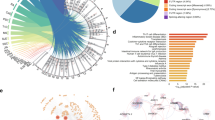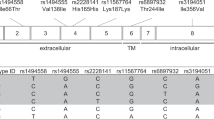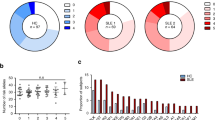Abstract
Systemic lupus erythematosus (SLE) is a complex autoimmune disease1 characterized by activation of the type I interferon (IFN) pathway2,3,4. Here we convincingly replicate association of the IFN regulatory factor 5 (IRF5) rs2004640 T allele with SLE5 in four independent case-control cohorts (P = 4.4 × 10−16) and by family-based transmission disequilibrium test analysis (P = 0.0006). The rs2004640 T allele creates a 5′ donor splice site in an alternate exon 1 of IRF5, allowing expression of several unique IRF5 isoforms. We also identify an independent cis-acting variant associated with elevated expression of IRF5 and linked to the exon 1B splice site. Haplotypes carrying the variant associated with elevated expression and lacking the exon 1B donor site do not confer risk of SLE. Thus, a common IRF5 haplotype driving elevated expression of multiple unique isoforms of IRF5 is an important genetic risk factor for SLE, establishing a causal role for type I IFN pathway genes in human autoimmunity.
This is a preview of subscription content, access via your institution
Access options
Subscribe to this journal
Receive 12 print issues and online access
$209.00 per year
only $17.42 per issue
Buy this article
- Purchase on Springer Link
- Instant access to full article PDF
Prices may be subject to local taxes which are calculated during checkout


Similar content being viewed by others
References
Alarcon-Segovia, D. et al. Familial aggregation of systemic lupus erythematosus, rheumatoid arthritis and other autoimmune diseases in 1,177 lupus patients from the GLADEL cohort. Arthritis Rheum. 52, 1138–1147 (2005).
Blanco, P., Palucka, A.K., Gill, M., Pascual, V. & Banchereau, J. Induction of dendritic cell differentiation by IFN-alpha in systemic lupus erythematosus. Science 294, 1540–1543 (2001).
Ronnblom, L. & Alm, G.V. A pivotal role for the natural interferon alpha-producing cells (plasmacytoid dendritic cells) in the pathogenesis of lupus. J. Exp. Med. 194, F59–F63 (2001).
Baechler, E.C. et al. Interferon-inducible gene expression signature in peripheral blood cells of patients with severe lupus. Proc. Natl. Acad. Sci. USA 100, 2610–2615 (2003).
Sigurdsson, S. et al. Polymorphisms in the tyrosine kinase 2 and interferon regulatory factor 5 genes are associated with systemic lupus erythematosus. Am. J. Hum. Genet. 76, 528–537 (2005).
Isaacs, A. & Lindenmann, J. Virus interference. 1 The interferon. Proc. R. Soc. Lond. B 147, 258–273 (1957).
Bennett, L. et al. Interferon and granulopoiesis signatures in systemic lupus erythematosus blood. J. Exp. Med. 197, 711–723 (2003).
Kirou, K.A. et al. Coordinate over-expression of interferon-alpha-induced genes in systemic lupus erythematosus. Arthritis Rheum. 50, 3958–3967 (2004).
Honda, K., Yanai, H., Takaoka, A. & Taniguchi, T. Regulation of the type I IFN induction: a current view. Int. Immunol. 17, 1367–1378 (2005).
Takaoka, A. et al. Integral role of IRF-5 in the gene induction programme activated by Toll-like receptors. Nature 434, 243–249 (2005).
Barnes, B.J., Moore, P.A. & Pitha, P.M. Virus-specific activation of a novel interferon regulatory factor, IRF-5, results in the induction of distinct interferon alpha genes. J. Biol. Chem. 276, 23382–23390 (2001).
Barnes, B.J. et al. Global and distinct targets of IRF-5 and IRF-7 during innate response to viral infection. J. Biol. Chem. 279, 45194–45207 (2004).
Lohmueller, K.E., Pearce, C.L., Pike, M., Lander, E.S. & Hirschhorn, J.N. Meta-analysis of genetic association studies supports a contribution of common variants to susceptibility to common disease. Nat. Genet. 33, 177–182 (2003).
Woolson, R.F. & Bean, J.A. Mantel-Haenszel statistics and direct standardization. Stat. Med. 1, 37–39 (1982).
Mancl, M.E. et al. Two discrete promoters regulate the alternatively spliced human interferon regulatory factor-5 isoforms. Multiple isoforms with distinct cell type-specific expression, localization, regulation, and function. J. Biol. Chem. 280, 21078–21090 (2005).
Morley, M. et al. Genetic analysis of genome-wide variation in human gene expression. Nature 430, 743–747 (2004).
Cheung, V.G. et al. Mapping determinants of human gene expression by regional and genome-wide association. Nature 437, 1365–1369 (2005).
Altshuler, D. et al. A haplotype map of the human genome. Nature 437, 1299–1320 (2005).
Spielman, R.S., McGinnis, R.E. & Evans, W.J. Transmission test for linkage disequilibrium: the insulin gene region and insulin dependent diabetes mellitus (IDDM). Am. J. Hum. Genet. 52, 506–516 (1993).
Barnes, B.J., Field, A.E. & Pitha-Rowe, P.M. Virus-induced heterodimer formation between IRF-5 and IRF-7 modulates assembly of the IFNA enhanceosome in vivo and transcriptional activity of IFNA genes. J. Biol. Chem. 278, 16630–16641 (2003).
Barnes, B.J., Kellum, M.J., Field, A.E. & Pitha, P.M. Multiple regulatory domains of IRF-5 control activation, cellular localization, and induction of chemokines that mediate recruitment of T lymphocytes. Mol. Cell. Biol. 22, 5721–5740 (2002).
Mitchell, M.K., Gregersen, P.K., Johnson, S., Parsons, R. & Vlahov, D. The New York Cancer Project: rationale, organization, design, and baseline characteristics. J. Urban Health 81, 301–310 (2004).
Hochberg, M.C. Updating the American College of Rheumatology revised criteria for the classification of systemic lupus erythematosus. Arthritis Rheum. 40, 1725 (1997).
Martin, E.R., Monks, S.A., Warren, L.L. & Kaplan, N.L. A test for linkage and association in general pedigrees: the pedigree disequilibrium test. Am. J. Hum. Genet. 67, 146–154 (2000).
Acknowledgements
We thank H. Yin and the members of the Uppsala Genome Center for help with sequencing and S. Young, J. Novitzke, L. Kyle, K. Espe, C. Gillett, P. Gaffney and K. Moser for assistance. The Swedish samples were obtained from the Lupus cohort at Karolinska University Hospital, Solna. This work was supported by grants from the Swedish Research Council (M.E.A.-R.), the Clas Groschinski Foundation (M.E.A.-R.), the Marcus Borsgtröms Foundation (M.E.A.-R.), the Torsten and Ragnar Söderberg's Foundation (M.E.A.-R.), the Swedish Association against Rheumatism (M.E.A.-R.), the Alliance for Lupus Research (M.E.A.-R., T.W.B.), the Lupus Research Institute (T.W.B.), the Mary Kirkland Center for Lupus Research (T.W.B.), the Lupus Foundation of Minnesota (T.W.B.), the National Institute of Allergy and Infectious Diseases of the US National Institutes of Health (NIH) (T.W.B.), the National Institute of Arthritis, Musculoskeletal and Skin Diseases of the NIH (R.R.G., E.C.B., T.W.B.) and the Ministerio de Ciencia y Tecnología (SAF2003-3460; J.M.). The Johns Hopkins Lupus Cohort is supported by NIH grant AR 43727, and the Johns Hopkins General Clinical Research Center is supported by NIH M01-RR-00052.
Author information
Authors and Affiliations
Corresponding authors
Ethics declarations
Competing interests
M.E.A.-R. owns shares in Everygene ΔB. This company has applied for a patent for some of the results presented here.
Supplementary information
Supplementary Table 1
Genotypic association of rs2004640 with SLE. (PDF 40 kb)
Supplementary Table 2
Association of HapMap phase II variants with IRF5 expression levels. (PDF 35 kb)
Supplementary Table 3
IRF-5 haplotype frequency in SLE cases and controls. (PDF 42 kb)
Supplementary Table 4
Hardy-Weinberg Equilibrium expectation test in control samples. (PDF 31 kb)
Supplementary Table 5
Primer sequences. (PDF 39 kb)
Rights and permissions
About this article
Cite this article
Graham, R., Kozyrev, S., Baechler, E. et al. A common haplotype of interferon regulatory factor 5 (IRF5) regulates splicing and expression and is associated with increased risk of systemic lupus erythematosus. Nat Genet 38, 550–555 (2006). https://doi.org/10.1038/ng1782
Received:
Accepted:
Published:
Issue Date:
DOI: https://doi.org/10.1038/ng1782
This article is cited by
-
Interferon Regulatory Factor 5 Gene Polymorphisms and mRNA Expression Levels Are Associated with Neuromyelitis Optica Spectrum Disorder
Molecular Neurobiology (2024)
-
Sex differences in the percentage of IRF5 positive B cells are associated with higher production of TNF-α in women in response to TLR9 in humans
Biology of Sex Differences (2023)
-
Remodeling articular immune homeostasis with an efferocytosis-informed nanoimitator mitigates rheumatoid arthritis in mice
Nature Communications (2023)
-
Emerging concepts of type I interferons in SLE pathogenesis and therapy
Nature Reviews Rheumatology (2022)
-
Regulation of the nucleic acid-sensing Toll-like receptors
Nature Reviews Immunology (2022)



